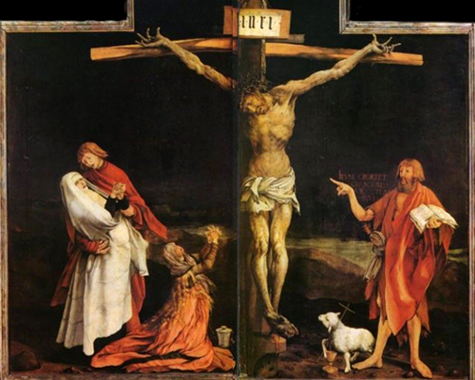A
t
B

"Look, the Lamb of God, who takes away the sin of the world!"
John 1, 29
John 1, 29

The Lamb of God - The lamb is one of the oldest symbols for Christ. It’s origin is in the Bible.
Originally the lamb was a sacrificial animal in the Israelite cult: Exodus 12. The Exodus, the 'going away' of the Israelites from Egypt took place after the 10th plague. Within this plague all firstborn sons in Egypt had to die. To save the sons of the Israelites, lambs had to die and their blood was used to paint jambs of the doors. Using this sign the angel of death spared their firstborn sons. - In memory of the Exodus the Jews celebrate the Passover every year, and for it they slaughter lambs.
The prophet Isaiah says about the lamb that it is led willingly to the slaughter: Isaiah 53, 7.
This is also understood as a metaphor for Jesus' way to Golgotha. - Jesus died at a Passover.
John, the Baptist, calls Jesus the "Lamb of God" which takes away the sins of the world: John 1, 29.
In the apocalypse of John the phrase is often used i. e.: Revelation 5, 1-14; 6, 1-17; 7, 17; 12, 11; 14, 1-5; 22, 10.
Agnus Dei (Lamb of God), part of the catholic Latin mass includes this idea too.
Often the theme of many pictures is Jesus as a Good Shepherd with a lamb on his shoulder.
Originally the lamb was a sacrificial animal in the Israelite cult: Exodus 12. The Exodus, the 'going away' of the Israelites from Egypt took place after the 10th plague. Within this plague all firstborn sons in Egypt had to die. To save the sons of the Israelites, lambs had to die and their blood was used to paint jambs of the doors. Using this sign the angel of death spared their firstborn sons. - In memory of the Exodus the Jews celebrate the Passover every year, and for it they slaughter lambs.
The prophet Isaiah says about the lamb that it is led willingly to the slaughter: Isaiah 53, 7.
This is also understood as a metaphor for Jesus' way to Golgotha. - Jesus died at a Passover.
John, the Baptist, calls Jesus the "Lamb of God" which takes away the sins of the world: John 1, 29.
In the apocalypse of John the phrase is often used i. e.: Revelation 5, 1-14; 6, 1-17; 7, 17; 12, 11; 14, 1-5; 22, 10.
Agnus Dei (Lamb of God), part of the catholic Latin mass includes this idea too.
Often the theme of many pictures is Jesus as a Good Shepherd with a lamb on his shoulder.

The Bible in Art and Culture
Isenheim Altar
by Matthias Grünewald
late medieval painting
European Cultural Heritage
At the bottom of the cross we can see a lamb. Looking at it from close up we see that the lamb is losing blood which pours into a communion-cup (chalice).
Jesus, the Lamb of God, gives his blood and with it his life, so that all people can live.
(1st Peter, 1, 18-21 --- Isaiah 53)
Isenheim Altar
by Matthias Grünewald
late medieval painting
European Cultural Heritage
At the bottom of the cross we can see a lamb. Looking at it from close up we see that the lamb is losing blood which pours into a communion-cup (chalice).
Jesus, the Lamb of God, gives his blood and with it his life, so that all people can live.
(1st Peter, 1, 18-21 --- Isaiah 53)